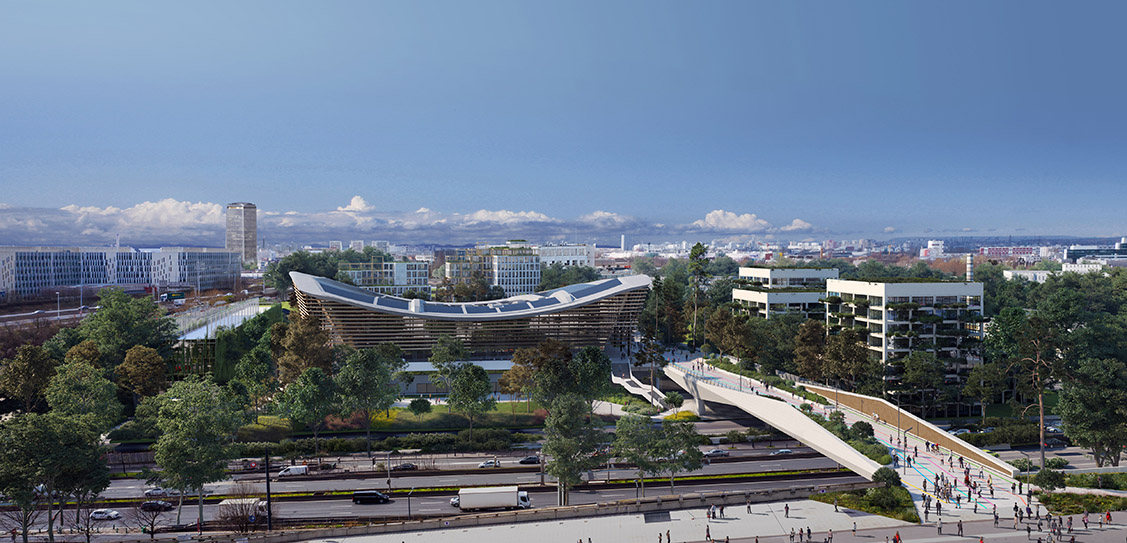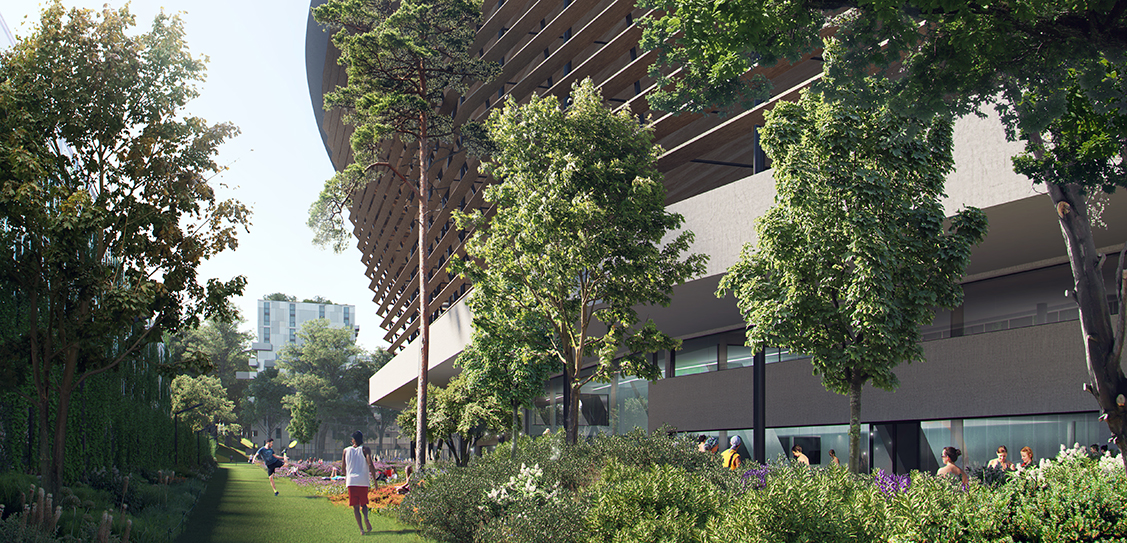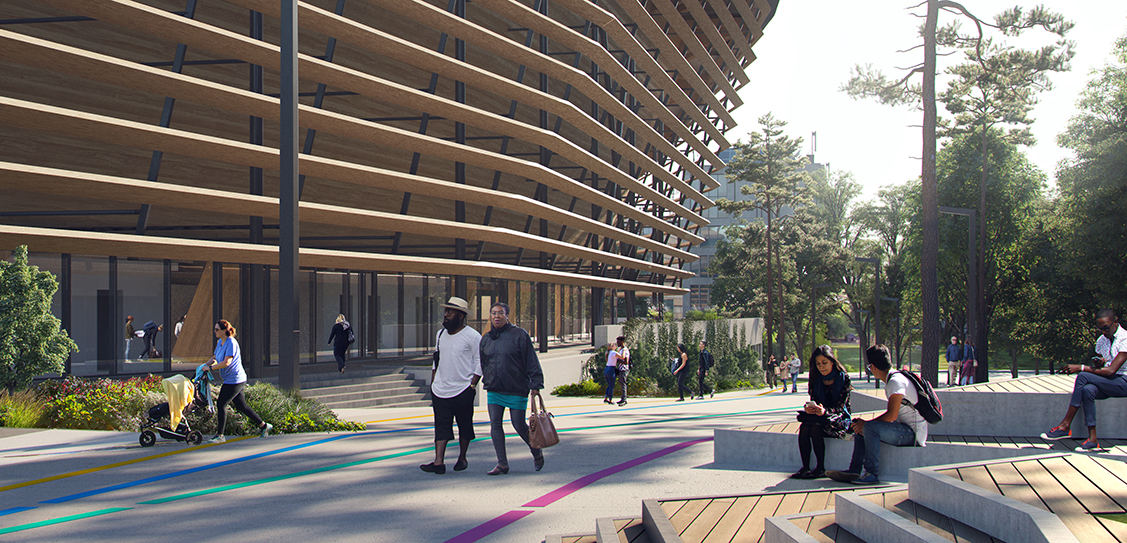The team won the design competition for the Parisian project, sharing an inspiring dialogue with the client La Métropole du Grand Paris, which aims to be completed for the Paris 2024 Olympic games.
The design includes a new pedestrian bridge that connects it with the existing ‘Stade de France’; the bridge will be the new gateway to the Aquatics Centre and the upcoming Eco neighbourhood which will be created after the games.
The centre is the only major facility that will be built for the games since 95% of the dedicated sites are already in place or will be temporary; the new Aquatics Centre will be situated on the former site of the Engie research centre.
Aspirations for the project are that it accomplishes being the most sustainable games in history so far. Sustainability and biodiversity are key in all aspects of the design. It is a modern and innovative sports complex surrounded by abundant vegetation that contributes to a livable and healthy city district for the people in Saint-Denis. To also stimulate a healthy lifestyle after the Olympics, the building will be open and transparent and accommodate a wide range of sports and events, both indoor and outdoor.
Nature was the main inspiration for the design concept. The Aquatics Centre also invites nature itself in the heart of the new ‘city-district-in-the-making’ of Saint-Denis. This very compact proposal creates room for 100 trees that will be planted to improve the quality of life and air, stimulate biodiversity and create new ecological connections.
Wood, one of the quintessential bio-based construction materials, is used to create the main structure of this building. The design of the Aquatics Centre features an impressive wooden roof, a suspended shape with minimal construction height that strictly follows the required minimum space for tribunes, people and sightlines, thereby minimising the amount of air that needs to be conditioned during the coming 50 years. By using wood for this monumental structure, the proposal doubles the required minimum percentage of bio-sourced materials. The Olympic arena, under the roof and with tribunes on three sides, can host 5,000 spectators around an innovative, modular and multifunctional competition pool.
Energy consumption is one of the big challenges for swimming pools, due to water treatment and high-temperature demands. By reducing the energy demand and creating a smart energy system, 90% of the needed energy can be provided with renewable or recovered energy. The solar roof will be one of the biggest solar farms in France and will cover 25% of all required electricity production, which is the equivalent of the electric power use of 200 households.
Water is both a key element of a swimming pool and one of the resources we should preserve most. With a very efficient water system, we can seriously reduce the need for freshwater, re-use 50% of the remaining water and still guarantee enough very clean water for all purposes.
Upcycling was also a main design principle; all furniture in restaurants, bars and entrances is made out of wood waste coming from the construction site and other demolition sites. All tribune chairs are newly designed and made out of 100% recycled plastic collected from schools in Saint-Denis.
The aquatic arena possesses a streamlined silhouette imagined as a strong and compact form presenting a single unifying image. A wooden sculpture emerging from a green landscape, a symbol on the metropolitan skyline, underscores its values of sustainability.
A broad ramp extends along the building from the park to the ZAC. Connected at several points, it transforms into a forecourt for the stadium and extends all the way from the pedestrian overpass at the A1 up to the plaza in front of the Stade de France this provides calm and secure access from the forecourt in front of the Stade de France to the Aquatics Centre and the entire Plaine Saulnier. The centre, its forecourt, gardens, access ramp, and the pedestrian overpass have been designed as a whole. Each of these elements possesses its own characteristics while also resonating with the others to create a single balanced and dynamic composition.
Football pitches for five-a-side games and the beach of the outdoor aquatic facilities are integrated into the landscape. The building has been designed to be as compact as possible to enable the development of a dense natural landscape. A great active ribbon of greenery surrounds the building and is open to the public spaces. The green strategy, between a composed and a country landscape, extends all the way to the plaza in front of the Stade de France.
The pedestrian overpass linking the Stade de France and the Aquatics Centre is designed in a simple and sober style. Its formal simplicity expresses its symbolism, which is to enable two sports facilities to exist which, facing each other, form a new entrance to Paris.
The built and planted elements of the project all follow the same functional, structural, and formal design logic based on a principle of harmony inspired by nature. It is from this design perspective that the entire stretched roof reached its ultimate expression. Like a leaf, the roof combines several functions in a single form; sheltering, filtering light, collecting rainwater, integrating technical networks, and finally, capturing the energy of the sun to transform it into the vital energy dedicated to the needs of the Aquatics Centre.
The functional, technical, and spatial requirements of this roof are integrated directly into its parametric design, thereby making it possible to create a powerful and streamlined form that meets the optimal balance of these requirements. Thus, the necessary volume of the spaces in the Olympic stadium minimises the energy used for heating and is created through a layer of wooden beams only 50cm in height and a span of approximately 80 m, in a thin skin. To minimise the number of required resources is to design the project placing the emphasis on life cycle optimisation. Top priority is given to bio-sourced materials; the structure, made entirely of wood, helps to reduce a considerable amount of CO² emissions compared with steel and concrete but also locks up CO². This includes future reuse and ensures that the CO² will remain outside the atmosphere for hundreds of years.
The upper forecourt is on the same level as the plaza in front of the Stade de France and offers views overlooking the aquatic stadium and the Olympic pool. Visitors to the major events of the Olympic Games will be able to take advantage of this space before accessing the stands. The lower forecourt, an extension of the park that also serves the main entrance, is a reception area and a place for meetings. It is connected to the sports mall located at the heart of the future Pleyel neighbourhood.
Made of lateral steel box girders, it supports a surface road also made of steel, with no intermediate support between the two plazas. Its expression is the same as its structure, balancing between the two esplanades. It embodies stability and uses simple, recognisable, and timeless forms that anchor it in a frugal and elegant style. This work forcefully and lightly crosses the A1 in a single span. Its light grey colour connects it visually with the roof of the Stade France and heralds the treatment of the exterior spaces of the Aquatic Centre.
The centre is a compact building that frees up important surface areas for landscaping. It is surrounded by composed and natural landscaped areas. This organisation is designed to reconnect the surrounding natural areas by creating strong and active green areas for different uses; sports, relaxation, and meeting places. The approaches to the centre are designed as a blended landscape taking into account the challenges posed by its function as a building, and the singularities of the places among which it is placed.
A grand and open space, the Olympic stadium is at the heart of the complex; the roof, stretched with wooden beams, magnifies the space thanks to its dynamic curves that make it both intimate and airy.
The inverted vault of the roof reaches the 80 m, required for receiving spectators around the competition pool lightly and delicately, like an immense stretched sail. The space is bathed in light thanks to two glazed tympanums on the East and West sides. To the East, the view is above the leaves of the trees and offers a sight of the Stade de France, a remarkable monument on the territory. It is the backdrop for the spectacle of the athletes using the diving tower. The multifunctional Olympic pool is installed from East to West, anchored to the base, and open to the Olympic stadium. The stands surround the pool on three sides, ensuring the arena effect is so appreciated by athletes and supporters.
The southern section of the first level is dedicated to the practice of wellness sports. This centre benefits from large spaces for cardio weight training as well as classrooms for yoga, dance, and meditation. The nearby games hall enables the visitor to easily combine activities; relax in the game pool after a gruelling sports session, or join a class of aqua bikes.
Block climbing is accessible, with climbers caught by thick mattresses in case of a fall. That is why the climbing space is positioned on the ground floor, in a vast area under the ramp linking with the north side, and directly connected to the entrance hall. Access to the changing rooms and the great, double-height hall is via the restaurant, which serves this centre and the entire complex. The space is bathed in light coming from the entrance hall and the grand, glazed western façade, but also from the great glazed curtain wall on the north side, which brings natural, homogenous, and diffuse light into the practice area.
The sports plateau is a vast space that extends across the area where the temporary stands are on level two. The exceptional dimensions that are available here can also host two-panel fields and two three-by-three basketball courts. These activities are broadly open to the stadium pool enabling the participants to see and be seen; to inspire each and everyone to practise other sports. This plateau is accessible directly from the entrance hall via a vertical staircase and extends in good weather to a broad terrace on the south side via the covered wooden cocoon in between.
Present both inside and outside, wood offers a grand continuity to the project. It invites the visitor to enter, sets the rhythm of the pathway and filters light and views. It also makes it possible to obtain rich colour and softness in the spaces where it is exposed. The structural elements of the sports stadium are all made of wood, implementing a unique and unexpected system that creates the magic of the place. The roof is supported by stretched wooden beams of a very long span, which are themselves pulled by oblique glulam tie beams.
The roof is installed with photovoltaic panels, turning the building into the largest urban photovoltaic farm in France. This new skin displays the sustainable aspect of the building and creates glimpses that evolve according to the weather through the interplay of luminosity and reflections. In addition to its form, the composition is also innovative because of its delicate structure and the technical implementation of the panels.
Construction is estimated to take 32 months with completion dated April 2024 for the Olympic committee, and Summer 2025 when it will to the general public.



